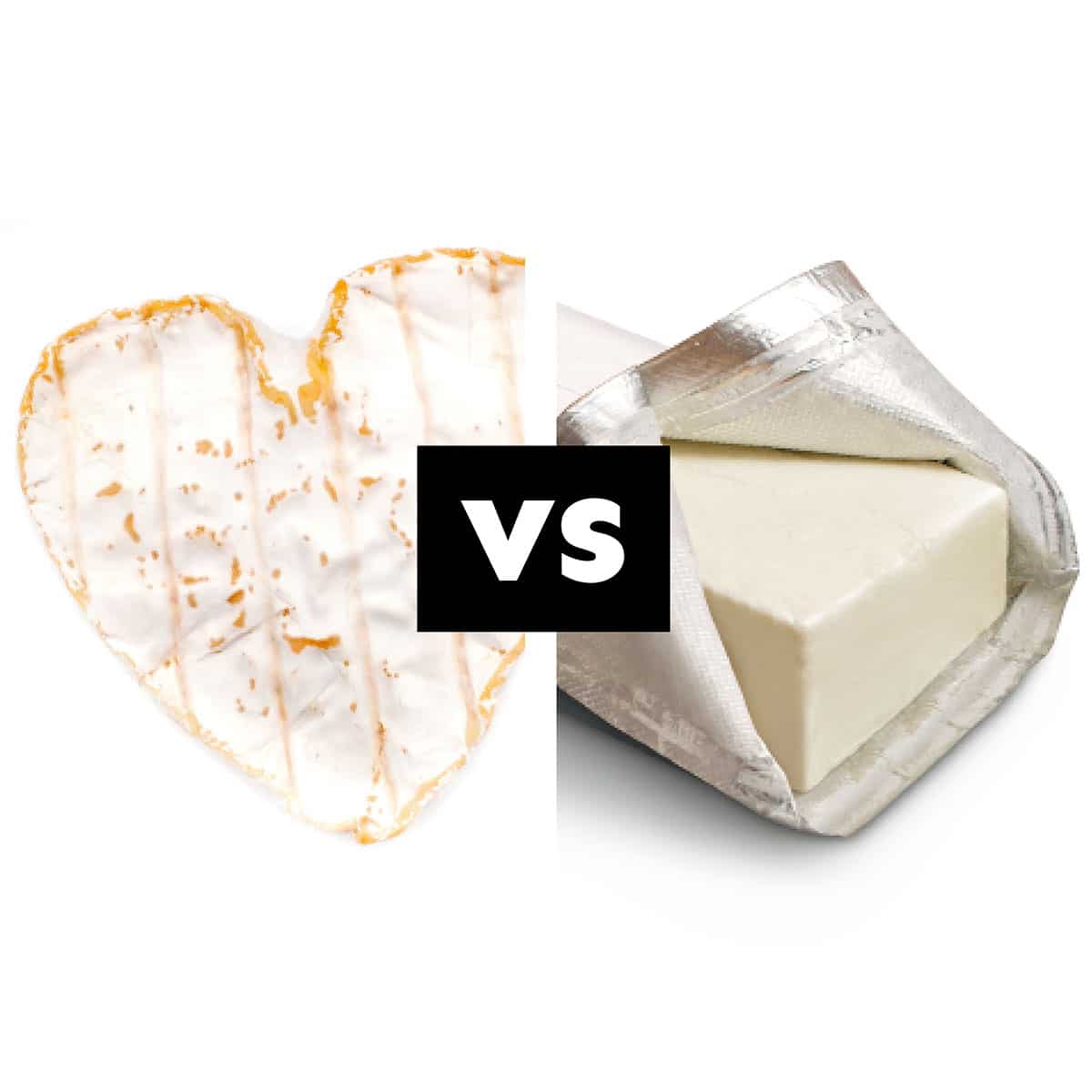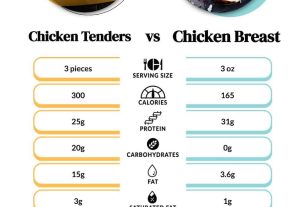Are you a fan of creamy and spreadable cheese?
If so, you’ve probably encountered Neufchâtel and cream cheese in your culinary adventures.
At first glance, these two may seem almost identical, packaged in similar ways, but don’t be deceived!
Beneath their familiar appearance lies a world of differences in taste, ingredients, and fat content.
From the unripened goodness of Neufchâtel to the silky smoothness of cream cheese, prepare to be intrigued by these rivals of the spreadable cheese kingdom.
neufchatel vs cream cheese
Neufchâtel and cream cheese are similar in appearance and packaging, but they have distinct differences in taste and ingredients.
Neufchâtel is an unripened cheese made with cow’s milk, while cream cheese contains milk and cream.
Cream cheese is smoother and milder in flavor, whereas French Neufchâtel is salty and becomes more pungent with age.
Neufchâtel is technically lower in fat content than cream cheese, often referred to as “light cream cheese.” Overall, Neufchâtel and cream cheese are distinct in taste and ingredients, providing different flavor profiles for various culinary uses.
Key Points:
- Neufchâtel is made with cow’s milk, while cream cheese contains milk and cream.
- Cream cheese is smoother and milder in flavor, while Neufchâtel is salty and becomes more pungent with age.
- Neufchâtel is technically lower in fat content and is often called “light cream cheese.”
- Neufchâtel and cream cheese have distinct differences in taste and ingredients.
- Both cheeses have different flavor profiles that can be used in various culinary dishes.
- Neufchâtel and cream cheese may look similar, but they are not the same.
neufchatel vs cream cheese – Watch Video
💡
Pro Tips:
1. Neufchâtel and cream cheese may appear to be similar, but they are actually made using different processes. Neufchâtel is a soft, spreadable cheese that originated in Neufchâtel-en-Bray, France, and is traditionally crafted from raw cow’s milk. On the other hand, cream cheese is an American invention, made from pasteurized cow’s milk and cream.
2. Neufchâtel and cream cheese also differ in their fat content. Neufchâtel generally contains slightly less fat than cream cheese, making it a slightly healthier option for those watching their calorie intake.
3. Did you know that both Neufchâtel and cream cheese have a tangy flavor? However, Neufchâtel has a slightly more pronounced tang, while cream cheese is known for its milder taste. The tanginess in both cheeses is due to the lactic acid bacteria used in the fermentation process.
4. Neufchâtel has an interesting connection to the American state of Pennsylvania. Known as “Philadelphia style” cream cheese, it was first produced in the Philadelphia area in the late 1800s. However, this cream cheese was derived from Neufchâtel, hence the connection between the two types of cheese.
5. Neufchâtel has an intriguing historical anecdote associated with it. During World War II, a version of Neufchâtel was used to create hollow balls that contained secret messages for the resistance. These “cheese balls” would be coated with a thin layer of wax and then transported without raising suspicion—a unique and unconventional use for this delicious cheese!
1. Appearance And Packaging Similarities
Neufchâtel and cream cheese may look deceivingly similar, as they often come packaged in similar containers. The white, creamy texture, and the ability to spread them smoothly on your favorite bagel or cracker can make them seem almost identical. However, it is important to note that these two soft spreads have distinct differences in taste and ingredients that set them apart.
2. Neufchâtel: Cow’s Milk And Soft Texture
Neufchâtel, originating in 6th century France, is one of the oldest known cheeses in the country. It is made with cow’s milk, and traditionally, the French version is crafted using only milk. The result is a soft, slightly grainy texture that distinguishes it from cream cheese. Neufchâtel has the ability to develop a delicate, soft rind similar to popular French cheeses like Brie or Camembert, adding a touch of sophistication to its overall allure.
- Neufchâtel cheese originated in 6th century France.
- It is made with cow’s milk.
- The French version is crafted using only milk, giving it a unique texture.
- Neufchâtel has a soft, slightly grainy texture that differentiates it from cream cheese.
- It can develop a delicate, soft rind similar to Brie or Camembert, adding sophistication to its overall appeal.
“Neufchâtel has a rich history as one of the oldest cheeses in France. Its soft, slightly grainy texture and ability to develop a delicate rind make it a captivating choice for cheese enthusiasts.”
3. Cream Cheese: FDA Definition And Flavor
Cream cheese is a type of cheese that is regulated by the FDA. According to the FDA, cream cheese must have a minimum fat content of 33% and a moisture content of 55% or less. This type of cheese is known for its smooth and mild flavor, which makes it a popular choice for spreads, dips, and fillings in pastries.
One of the most well-known brands of cream cheese is Philadelphia Cream Cheese. This brand made its debut in New York in 1872 and later adopted the name “Philadelphia” in 1880. The intention behind this name change was to associate the brand with the esteemed food and dairy farming associated with Philadelphia at that time.
4. Origin Of Philadelphia Cream Cheese
Philadelphia Cream Cheese, invented in 1872 in New York, quickly became a beloved staple in American households. Its name, adopted in 1880, aimed to align the product with the high-quality food and dairy farming that Philadelphia was renowned for. With its creamy texture and mild flavor, Philadelphia Cream Cheese has remained an iconic brand in the world of soft spreads till date.
5. Neufchâtel: Light Cream Cheese
One interesting aspect of Neufchâtel cheese is its lower fat content compared to cream cheese, earning it the moniker of “light cream cheese.” While cream cheese typically contains at least 33% fat, Neufchâtel must contain more than 20% milkfat but less than 33%. This distinction may appeal to those seeking a healthier alternative without compromising on flavor.
6. Neufchâtel: Ancient French Cheese
Neufchâtel is a cheese with ancient origins, dating back to the year 1035 in northern Normandy, France. It is named after the hamlet of Neufchâtel-en-Bray. This delectable cheese has gained popularity and remains a favorite among cheese enthusiasts worldwide.
- Neufchâtel is primarily made with cow’s milk, which contributes to its rich and creamy texture.
- The cheese embodies the traditions and craftsmanship of centuries past, representing the essence of French culinary heritage.
“Neufchâtel, a cheese with a long history, captures the essence of French culinary heritage.”
7. Salty And Pungent French Neufchâtel
French Neufchâtel possesses a unique flavor profile that sets it apart from its cream cheese counterpart. It is known for its salty taste, which becomes more pronounced as the cheese ages. The longer it ripens, the more it develops its pungent characteristics, creating a complex and savory experience. This characteristic flavor makes French Neufchâtel an excellent choice for spreading over a warm baguette or incorporating into flavorful recipes.
8. Moisture And Fat Content Of Neufchâtel
Neufchâtel and cream cheese have distinct differences in terms of moisture and fat content. Neufchâtel is required to have a maximum moisture content of 65%, which gives it a soft and spreadable consistency. Additionally, its fat content range is between 20% and 33%. These specifications are what give Neufchâtel its unique texture and mouthfeel. As a result, Neufchâtel is a versatile cheese that can be enjoyed in a variety of culinary applications.
- Neufchâtel has a maximum moisture content of 65%
- The fat content of Neufchâtel falls between 20% and 33%
9. Neufchâtel: Named After Neufchâtel-En-Bray
Neufchâtel cheese is named after the charming hamlet of Neufchâtel-en-Bray located in northern Normandy. This cheese has a strong historical connection to the region and is deeply embedded in its cultural heritage. Drawing inspiration from the local terroir and traditional methods, Neufchâtel reflects the unique character of this captivating corner of France. It has gained popularity among cheese enthusiasts due to its rich history and irresistible charm.
- Neufchâtel takes its name from Neufchâtel-en-Bray in northern Normandy
- This cheese has a strong association with the region and its cultural heritage
- It incorporates the local terroir and traditional techniques
- Neufchâtel embodies the essence of this enchanting corner of France
- It has captivated cheese enthusiasts with its charm and history.
10. French Neufchâtel: Raw Cow’s Milk
French Neufchâtel is traditionally made using raw cow’s milk, which imparts distinctive flavors and aromas, enhancing the cheese’s character. Despite evolving regulations, raw milk Neufchâtel remains highly sought after for an authentic and unadulterated taste of France.
Neufchâtel and cream cheese may appear similar and be packaged alike, but their differences in taste and ingredients are notable. Neufchâtel has a rich history dating back over a millennium, while cream cheese gained popularity in 19th century New York. With its lower fat content and unique salty flavor, Neufchâtel is a lighter alternative, while cream cheese is known for its smooth, mild taste. Both of these soft spreads offer their own distinct delights to elevate your culinary experiences, whether you prefer the savory pungency of French Neufchâtel or the creamy indulgence of cream cheese.
💡
You may need to know these questions about neufchatel vs cream cheese
Is Neufchatel cheese better than cream cheese?
Neufchâtel cheese offers a unique alternative to cream cheese due to its lower fat content and typically higher moisture content. While cream cheese boasts a rich and creamy texture, Neufchâtel tends to be slightly lighter and more spreadable. It all comes down to personal preference – if you prefer a creamier and higher fat option, cream cheese is the way to go. However, if you’re looking for a lighter option that still delivers on taste and versatility, Neufchâtel cheese may be the better choice for you.
Can you substitute Neufchatel cheese for cream cheese?
Yes, you can substitute Neufchatel cheese for cream cheese. While Neufchatel has a slightly grainy texture and lower fat content, it is still creamy and spreadable. Although the recipe won’t be as rich, Neufchatel cheese works well as a substitute, especially when baking.
What is the difference between cream cheese Neufchâtel and baker’s cheese?
Cream cheese Neufchâtel and baker’s cheese differ in their fat content and richness. Neufchâtel, labeled as “low-fat cream cheese,” contains a minimum of 20% fat, making it lower in fat compared to regular cream cheese. On the other hand, baker’s cheese is essentially fat-free and touted as “fat-free cream cheese.” While Neufchâtel maintains some of the creaminess of traditional cream cheese, baker’s cheese is noticeably less rich. Despite its lower fat content and lower price, baker’s cheese offers a lighter option with less richness compared to cream cheese Neufchâtel.
Which is healthier cream cheese or Neufchatel?
When comparing the health benefits of cream cheese and Neufchatel, it is evident that Neufchatel has a slight advantage. With one-third less fat and lower saturated fat content, Neufchatel has 80 calories, 6 grams of fat, and 4 grams saturated fat in just 2 tablespoons. This makes Neufchatel a healthier option for those looking to reduce their fat intake. However, it is worth noting that cream cheese can still be incorporated into a balanced diet as it can enhance the flavor of various healthy recipes.
Reference source
https://www.allrecipes.com/neufchatel-cheese-vs-cream-cheese-difference-7489205
https://www.masterclass.com/articles/neufchatel-cheese-vs-cream-cheese-explained
https://www.southernliving.com/food/dairy/cheese/cream-cheese-substitutes
https://m.youtube.com/watch?v=GCgJ8XFDmX0



